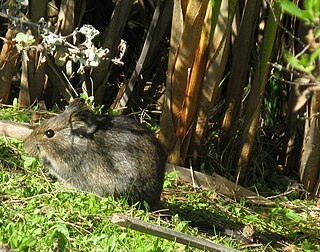
African vlei rats (Otomys), also known as groove-toothed rats, live in many areas of sub-Saharan Africa. Most species live in marshlands, grasslands, and similar habitats and feed on the vegetation of such areas, occasionally supplementing it with roots and seeds. The name "vlei" refers to the South African term for intermittent, seasonal, or perennial bodies of standing water.
The Angolan vlei rat is a species of rodent in the family Muridae. It is found only in Angola. Its natural habitats are dry savanna, moist savanna, and subtropical or tropical seasonally wet or flooded lowland grassland. It is threatened by habitat loss.
The Angoni vlei rat is a species of rodent in the family Muridae. It is found in Botswana, Kenya, Malawi, Mozambique, South Africa, Eswatini, Tanzania, Zambia, and Zimbabwe.
Barbour's vlei rat is a species of rodent in the family Muridae. It is found in Kenya and Uganda. Its natural habitat is subtropical or tropical high-altitude shrubland. It is threatened by habitat loss.
Burton's vlei rat is a species of rodent in the family Muridae. It is found only in Cameroon. Its natural habitats are subtropical or tropical high-altitude shrubland, subtropical or tropical high-altitude grassland, and swamps. It is threatened by habitat loss.
Dent's vlei rat is a species of rodent in the family Muridae. It is found in Burundi, Democratic Republic of the Congo, Malawi, Tanzania, Uganda, and Zambia. Its natural habitats are subtropical or tropical moist montane forests, subtropical or tropical high-altitude shrubland, and subtropical or tropical high-altitude grassland. It is threatened by habitat loss.
Dollman's vlei rat is a species of rodent in the family Muridae. It is found only in Kenya. Its natural habitats are subtropical or tropical high-altitude grassland and swamps. It is threatened by habitat loss. Some authorities, including the IUCN, regard it as a synonym of Otomys tropicalis.

The Mount Elgon vlei rat is a species of rodent in the family Muridae. It is found in Kenya and Uganda. Its natural habitat is subtropical or tropical high-altitude grassland. It is threatened by habitat loss.
The western vlei rat is a species of rodent in the family Muridae. It is found in Cameroon and Nigeria. Its natural habitats are subtropical or tropical high-altitude grassland and swamps. It is threatened by habitat loss.
Saunder's vlei rat is a species of rodent in the family Muridae. It is found only in South Africa. Its natural habitats are subtropical or tropical dry shrubland, Mediterranean-type shrubby vegetation, and subtropical or tropical high-altitude grassland.
The tropical vlei rat is a species of rodent in the family Muridae. It is found in Burundi, Democratic Republic of the Congo, Kenya, Rwanda, South Sudan, and Uganda. Its natural habitats are subtropical or tropical seasonally wet or flooded lowland grassland, subtropical or tropical high-altitude grassland, swamps, and plantations.
The Ethiopian vlei rat is a species of vlei rat in the rodent family Muridae. It is found only in Ethiopia and is considered endemic.
The Uzungwe vlei rat is a species of rodent in the family Muridae. It is found in Malawi, Tanzania, and Zambia. Its natural habitats are subtropical or tropical high-altitude grassland and swamps. It is threatened by habitat loss.
The Cheesman's vlei rat is a species of rodent in the family Muridae. It is considered endemic to northwestern Ethiopia.
The Simien vlei rat is a species of rodent in the family Muridae. It is found in northern Ethiopia.
The Yalden's vlei rat is a species of rodent in the family Muridae. It is found in the Bale Mountains, in southwestern Ethiopia.
Thomas's vlei rat is a species of rodent in the family Muridae. It is endemic to Kenya's high plateau mountains of the Rift Valley.
Mount Kilimanjaro vlei rat is a species of rodent in the family Muridae. It is found in north-eastern Tanzania, on Mount Kilimanjaro.
Charada vlei rat is a species of rodent in the family of Muridae. It is endemic to southwestern Ethiopia.
Heller's vlei rat is a species of rodent in the family of Muridae. It is endemic to Ethiopia and is found on the Arussi Plateau and the Bale Mountains.



